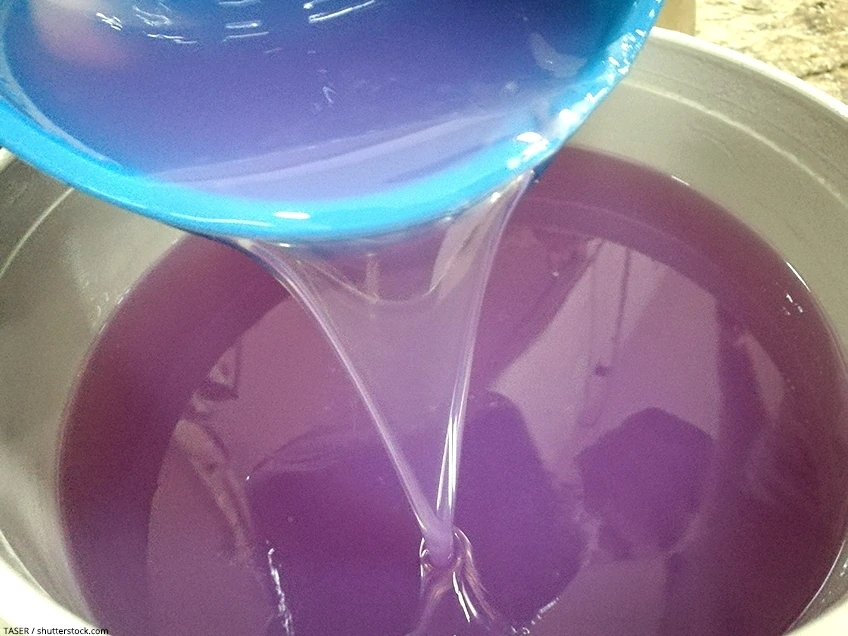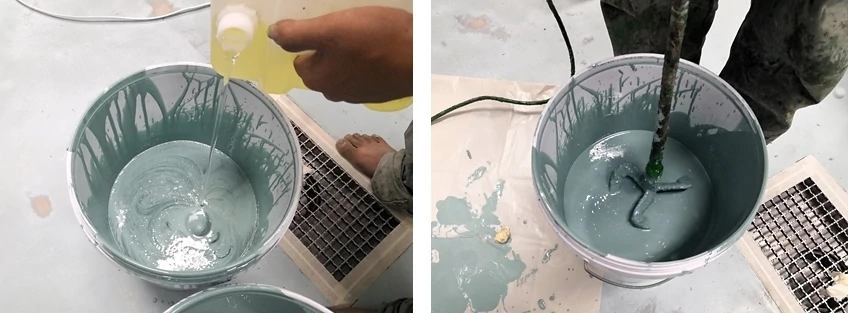Polyurethane Resin Guide – Everything you need to Know
This post may contain affiliate links. We may earn a small commission from purchases made through them, at no additional cost to you. You help to support resin-expert.com
If you want to work with resin, you are spoilt for choice. There are several different resins available on the market, and each type has its advantages and disadvantages – including polyurethane casting resin. In our Polyurethane Resin Guide, we give you the most essential polyurethane casting resin properties and tell you what to look out for when buying polyurethane.
Table of Contents
What is Polyurethane Resin?
Generally speaking, polyurethanes are synthetic resins or plastics that result from a polyaddition reaction between dialcohols or polyols and polyisocyanates.
Polyurethane casting resin has a wide range of properties that vary from application to application and cover a wide range of possibilities. Thus, not only thermoplastics but also thermosets and elastomers are produced from it.
In general, the casting resin consists of a two-component system of resin and hardener, which hardens after mixing through a chemical reaction. PU casting resins can, just like epoxy resin and polyester resin, be combined with various additives as well as filling materials or colorants. This gives them the desired properties. For example, the user can add an inhibitor to the resin to increase the so-called pot life, i.e., the processing time. As a result, this can be made very variable to suit any application.
There are also color pigments and fluorescent dyes that can give the polyurethane resin a specific color. This allows you to adapt the resin to your own requirements. Examples of fillers are, among others, cotton flocks, glass fibers, mineral fillers, and lightweight fillers. With these, the user can influence properties such as mechanical strength, stiffness, or surface hardness.
Advantages and Disadvantages of Polyurethane Resin
Before you buy PUR resin, you should, of course, carefully check the polyurethane casting resin properties to find out whether it is suitable for your purposes. In general, PU cast resin is a very pleasant material with many advantages and only a few disadvantages.
Pros
- It has excellent flow properties and can, therefore, be easily mixed and processed
- However, its viscosity is not too high, so that it can be optimally cast and shaped
- It hardens quickly and its demolding time is very short
- It has a good filling capacity
- It can also be used to produce very small and thin-walled models, which nevertheless exhibit high stability
- It is suitable as electrical encapsulant
- You can mix in a wide variety of additives such as inhibitors, filling materials, and color pastes
- There is only a small amount of shrinkage during curing
- It has a very high heat resistance after curing
- Depending on the composition, both elastomers and thermosetting plastics are available; the former can be joined together by vulcanization after curing
Cons
- It has a high sensitivity to moisture, which can cause undesirable reactions such as foaming
- To become insensitive to UV light, certain additives are required
- It is not weldable after curing
- During curing, the styrene causes a strong odor and thus a potential health hazard
- The adhesive property of PU resin is less than that of epoxy resin
PU resins that have to be processed quickly, but at the same time can also be unmolded quickly, are generally called fast-casting resins. If you want to work with such a resin, you must, therefore, pay attention to the pot life, otherwise the material hardens too quickly, and you have to start again from the beginning. This can be seen as a disadvantage, but also as an advantage, because after all, it also results in it being quick to unmold.
If you want to buy polyurethane resin, you should also check the hardness level and whether it is suitable for your project. The degree of hardness is indicated in Shore and should be noted on the respective packaging. After curing, soft materials are indicated in Shore hardness A and harder materials in Shore hardness D. The former have a rubber-like consistency.
Application Areas of PU Resin
The areas of application for PU resin are incredibly diverse. Polyurethane casting resin is a fascinating material for both industry and the do-it-yourselfer.
For example, foams can be produced from PU, but also paints, adhesives, and coatings. However, PU also protects electronic assemblies from a wide range of environmental influences such as mechanical stress or moisture. Therefore, these are usually encapsulated.
But also for the production of damping and spring elements, casting tires, instrument transformers for medium and high voltage technology, drive elements as well as various wearing parts, the PU resin has become invaluable.
In contrast to the production of foam, where a reaction with water and the resulting foam formation is desired, in all other applications, the surfaces with which the liquid PU resin comes into contact should be completely dry. Otherwise, the polyurethane casting resin may lose its favorable properties.
Floor Coatings
Polyurethane casting resin is particularly popular in industrial buildings such as car workshops or various halls, as it not only scores points visually and protects the underlying floor – often concrete – from high loads, but also has many other positive properties. As a floor covering, it is abrasion-resistant and very elastic. It withstands not only high thermal but also mechanical loads and is easy to apply. Furthermore, it is not too cost-intensive.
- Breathable two component waterborne urethane, clear topcoat for Supercoat epoxy floors, non-yellowing
- Industrial grade, Good chemical resistance, High gloss finish, Resists damaged caused by gasoline, brake fluid, standing water and battery acid
- Protects epoxy floor from scratches, Encapsulates decorative flake, easy to clean
In outdoor applications, it should be preferred over epoxy resin coating because, unlike the latter, it does not have a tendency to yellow due to its high UV resistance and can also withstand sharp temperature fluctuations optimally. Polyurethane resin coatings are also often used in kindergartens and schools, as they reduce the risk of slipping and accidents.
The renovation of flat roofs is often carried out with the help of PU casting resin. The casting resin offers significant advantages, as it is easy to apply and very durable. Here, too, the material’s high UV resistance comes into play.
Polyurethane Casting Resin for Mold Casting
In mold casting, both liquid components mixed together are poured into a mold. The material then hardens.
Due to its low viscosity and various other properties, polyurethane resin is ideally suited for mold casting, regardless of whether the mold is lost or reusable. However, if you want to cast polyurethane, there are two things to consider:
- Casting resin for Making models, molds, protoypes, figurines, proof molds, make reproductions, etc..
- Model-Pro turns from liquid to solid in 15 minutes and works excellent in silicone molds
- Model-Pro is a two component polyurethane casting resin which exhibits good impact resistance and strength.
- The PU casting resin can only be removed from the mold if it has been treated with a release agent beforehand
- With elastic polyurethanes, damage to the master model is possible, since the curing process generates high temperatures
Fields of application for mold casting are, among others, the following:
- Encapsulation and manufacturing processes of electronic components, such as semiconductors, assemblies, and insulators
- Casts and use in the restoration of monuments and buildings
- Wrapping of perishable objects and with it the use as transparent sealing
- Coating and glazing of various objects
- Model making, especially as a reproduction of water bodies
- Potting of open contact points on cables
mold casting enjoys great popularity both in industry and among small users and can be carried out not only by machine but also by hand. It is important that the casting resin is carefully mixed and poured slowly into the mold; otherwise, too many air bubbles will be added. After filling, you can lightly tap the filled mold with your fingers a few times to allow the air bubbles to escape. To avoid too much air being mixed in, you can fill the mold from below instead of pouring in the resin from above.
In industry, both casting compound and casting are dried in some plants using vacuum and degassed beforehand.
Processing of PU Casting Resin – Step-by-Step Instructions
How exactly you process PU casting resin naturally depends on its intended use. In our polyurethane resin guide, we assume its use as a floor coating on concrete as well as mold casting.
- Before you cast the polyurethane resin, prepare all the necessary materials, because the processing time of two-component PU casting resin is naturally limited. If in doubt, mix less of the mixture or add an inhibitor if you want to work large areas or pour large molds.
- When used as flooring, the floor must be prepared first. Clean it thoroughly from dust, dirt, and grease. Fill any joints and cracks so that the entire floor is level. Of course, you should let the leveling compound dry first before applying the casting resin. After you have prepared the substrate, you can prime the floor. Ideally, use a two-component primer based on PU resin without solvents.
Before the actual pouring of the PU resin, it is recommended that a base primer be applied as a floor coating. Images: bhakpong – stock.adobe.com
- Now you can mix the polyurethane resin mixture if you are working with two components. This step is, of course, not necessary if you are working with only one element.
- Follow the manufacturer’s instructions when mixing. Stir as thoroughly as possible and also pour the mixture once or twice to ensure that the two components are perfectly blended together.
- After mixing, the casting resin is applied or poured into the mold. For floor coatings, the desired thickness is usually only a few millimeters, but for all other objects, it depends, of course, on the nature of your project. If you do not want to use the resin to cast a floor covering but to cast a mold, you must treat the mold used with a suitable release agent beforehand.
During the mixing process, it is strongly recommended to work extremely thoroughly. Images: Chinnabanchon9Job / shutterstock.com
- Now the resin has to cure naturally. How long this takes also depends on your project and the type of resin used. Both cold-curing and hot-curing resins are available. Some PU casting resins can even be cured using ultraviolet radiation, for example, from a UV lamp.
- Caution is required when casting large objects, as the curing process can cause relatively large areas of shrinkage. You can counteract this by re-casting. However, you must be careful not to include blowholes or external indentations. After complete curing, it is no longer possible to re-cast the material, otherwise there is a risk of cracks or at least internal stresses in the material.

- During the curing process, also pay attention to the heat given off by the exothermic process. It should be possible to dissipate this heat accordingly, as otherwise, the temperatures in the casting will continue to rise, and the hardening process will be accelerated too much. This can also cause weak points in the material.
- Objects that have been cast with PUR can be further processed as desired after cleaning and thorough removal of the release agent. They can be primed as well as painted. If the resulting object is to be used outdoors, it is recommended that it be painted to increase its resistance to UV light and weathering.
Storage and Durability of PUR Casting Resins
When storing polyurethane casting resin, care must be taken to avoid large temperature fluctuations. In general, PUR casting resin should be stored at a temperature of 15 to 25 degrees Celsius in closed containers. Make sure that the packaging is airtight and moisture-proof when opened. Process the opened containers as quickly as possible and shake the two components carefully but thoroughly before mixing.
It is possible that the PU resin may crystallize slightly during storage. Then you can warm it up slowly and carefully to a maximum of 70 degrees Celsius to decrystallize it. In this case, let it cool down to room temperature before you process it further.
Safety Instructions for Processing Polyurethane Casting Resin
- The isocyanates contained in polyurethane casting resin are allergenic and may cause cancer. However, these properties only apply to the material that has not yet reacted. Once the reaction is complete, no further health hazards are to be expected from the material. Nevertheless, you should exercise caution when handling the PU casting resin.
- Various additives can also be harmful to health, such as plasticizers or flame retardants.
- Always follow the information provided by the manufacturer when working with the PU casting resin. Use respiratory protection and gloves during your work process and wear long-sleeved clothing. Ventilate your workplace well and make sure you have all the tools you need at hand.
- Avoid open fire in the vicinity. Should the mixture come into contact with your eyes or mucous membranes, rinse them thoroughly for several minutes and then consult a doctor.
Questions and Answers
What is Polyurethane?
Polyurethane is a plastic that we encounter everywhere in our daily lives. It has various favorable properties which are not only used by industry but also by private users. PUR is created by an exothermic, i.e., heat-releasing polyaddition reaction.
Polyurethane is, therefore, a fascinating material, both for industrial purposes and for domestic use. Its easy application and its many positive properties enable a clean production even without much previous knowledge.








